The next two blogs (including this one) are a result of our recent river cruise from Budapest to Amsterdam. Along the way, we floated up and down three different rivers, one big canal, and went through sixty-eight locks (yes, you read this correctly—68 locks). One of the primary reasons we chose this trip was the day-visit to Nuremburg, Germany and the “World War II Excursion.” The alternate excursion was to the Nuremburg Toy Museum so you can guess it wasn’t a hard choice for us.
We visited two historical sites: Zeppelin Field where the massive pre-war night-time Nazi rallies were held and the interior of the courtroom where the highest surviving Nazi leaders were tried in 1945/46 on four counts, including crimes against humanity.
Nazi Party Rally Grounds
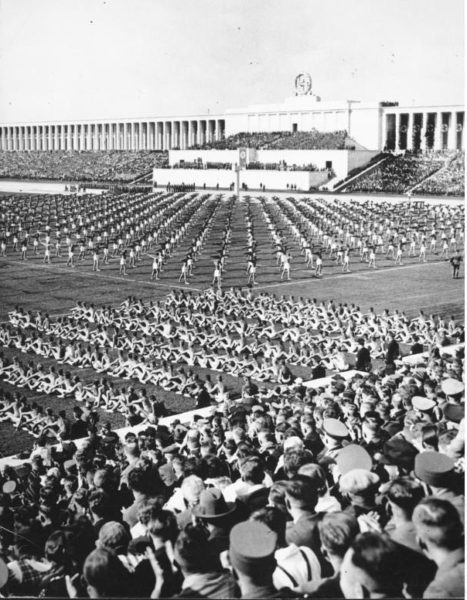
Located southeast of the old town of Nuremberg, Zeppelinfeld (Zeppelin Field) is part of a larger complex known as the Nazi Party Rally Grounds. In August 1909, Count von Zeppelin landed one of his airships on this location thereby giving the field its name. Other buildings on the grounds included the Luitpoldarena (deployment area), the Luitpold Hall (“Old Congress Hall”—damaged during the war and later demolished), the Kongresshalle (“Congress Hall”—still standing but never fully completed), the Märzfeld (March field—demolished), the Deutsche Stadion (“German Stadium”—only its foundations were built), the Stadion der Hitlerjugend (“Stadium of the Hitler Youth”—today it’s the Frankenstadion), and the Große Straße (“Great Road”—completed but never used). Only the Zeppelin Field, the Luitpoldarena, and the Große Straße were completed by the Nazis. By 1939, the focus of the Nazi party was on obtaining the labor and materials needed to support the German war efforts and not on the completion of their rally grounds (the last rally, “The Party Rally of Peace” scheduled for 2 September 1939, was abruptly cancelled when Hitler attacked Poland on 1 September 1939).
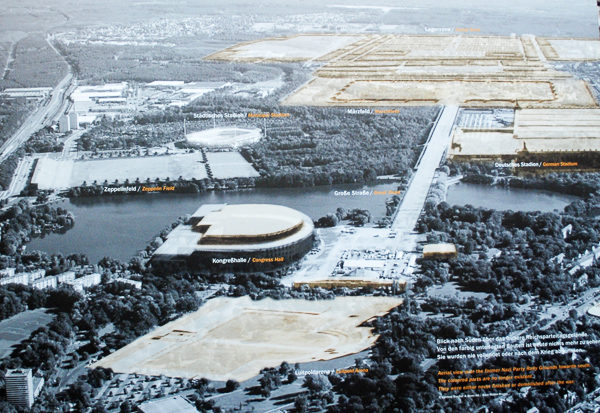
Watch current and historical video.
Nuremberg was chosen by Hitler to be the site where the Reichsparteitage (Reich Party Congresses) met between 1923 and 1938. The primary function of the Party Congress was to demonstrate the unity of Germany and the National Socialist Party. To achieve this objective, the Party Congress developed the rallies which would become huge propaganda successes. To design and build a complex that would match his expectations, Hitler turned to his favorite architect: Albert Speer.
Today, tourists arrive by bus loads to disembark and walk around Zeppelin Field. Most then move on to Congress Hall where the Documentation Center is located. It is an excellent presentation of how Germany came under the influence of Hitler and his gang of criminals. The exhibit doesn’t pull any punches and because Germany never wants its citizens to forget the evils of its Nazi past, all new soldiers are required to go through the Documentation Center as part of their basic training.
The Party Rallies
The focal point of the Party Rally Grounds is the Zeppelin Field. It is here that contemporary newsreels, documentaries, and propaganda movies recorded the massive rallies each year between 1933 and 1938 (the 1933 rally was known as “The Party Rally of Victory”). It provided a central stage for the Nazis with the world as its audience.
The area itself is larger than twelve football fields and more than 200,000 participants could act out their choreographed marches, dances, and military parades in front of Hitler, his invited guests, and hundreds of thousands of spectators circling the field.
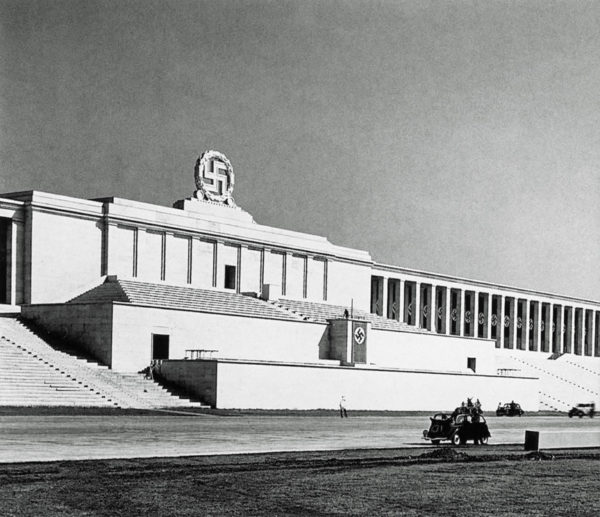
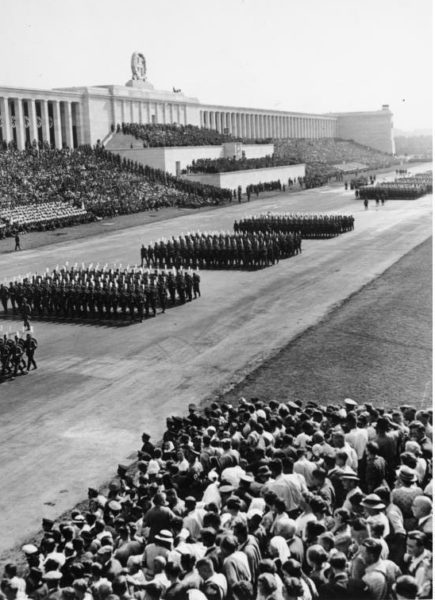
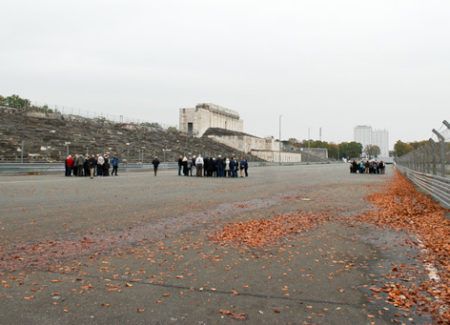
Despite the National Socialists holding their non-sanctioned rallies at various places around Nuremberg between 1927 and 1929, it wasn’t until Hitler became chancellor that he declared all future party rallies would be held in Nuremberg on the Party Rally Grounds and Zeppelin Field.
The Architecture
The Zeppelin Field consisted of a large grandstand, a speaker’s podium, a smaller stand for VIPs, and the rampart-like stands with 34 towers surrounding the field. Atop the building and centered behind the grandstand stood a giant gilded stone swastika. On the left and the right ends of the grandstand were two massive wing towers. In between the wings was a double-row of pillars.
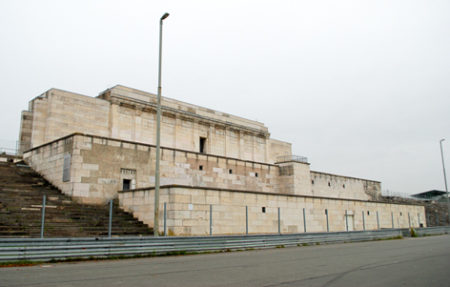
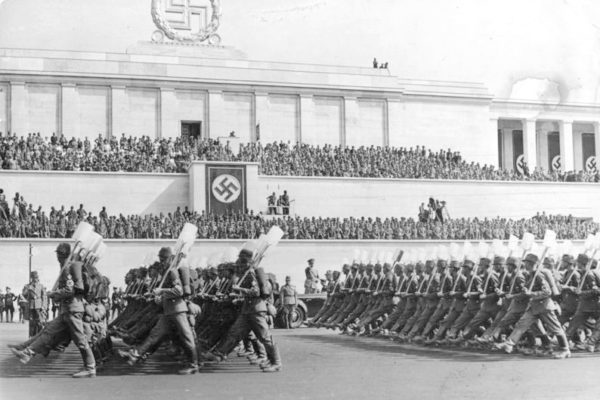
The speaker’s rostrum in the center of the grandstand was built so that everyone from the VIPs to the participants to the spectators had to look up at the “Führer.” Everything, including the rally itself, was designed to elevate Hitler and the cult he was developing.
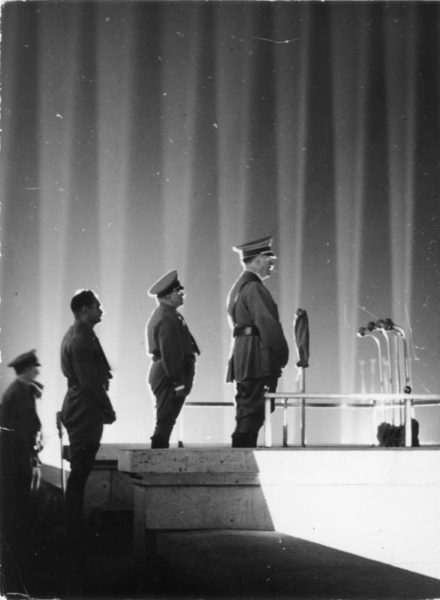
Speer designed the field and its stands to accommodate more than 150 powerful floodlights. Placed all around the field, their beams at night were angled straight up into the sky creating what was called the “Cathedral of Light.”
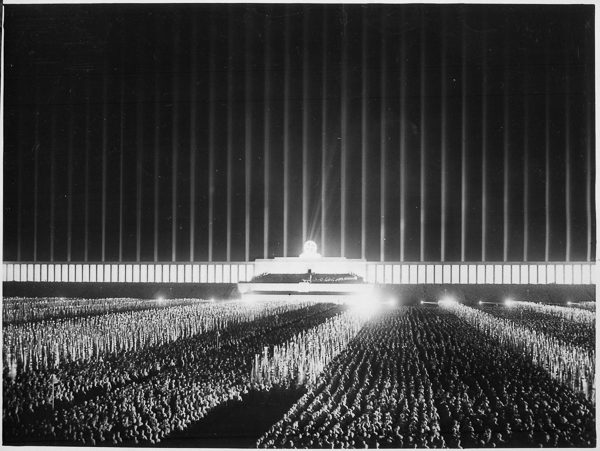
Leni Riefenstahl
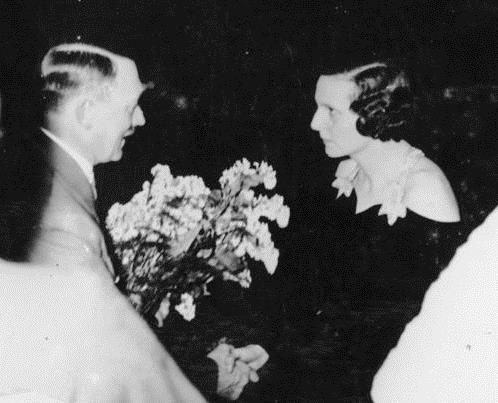
One of the people closely associated with the Nazi rallies during the 1930s is Leni Riefenstahl (1902−2003). Riefenstahl was a German film director, producer, screenwriter, actress, and photographer among other talents. She is infamous for being one of the last survivors of Hitler’s inner circle and for creating films that glorified the Nazi regime. Her films, including Triumph des Willens (“Triumph of the Will”) and Olympia (the 1936 Summer Olympic), are considered masterpieces of Nazi propaganda.
She claimed to have never known about the Holocaust or the Nazi terrorism yet it has been proven that she knew the unpaid workers for several of her war-time movies were Roma (gypsies) from local detention camps who, after completing their work, would be deported to Auschwitz for extermination.
It is generally thought that her greatest work was Triumph des Willens, a film about the 1934 party rally in Nuremberg. For this film and Olympia, Riefenstahl created several innovative film techniques including slow motion, tracking shots, and camera angles. However, it was Nazi propaganda films like these that followed her for the remainder of her long life.
April 1945
On 17 Aril 1945, the US Army marched into Nuremberg and three days later secured the city. On 22 April 1945, they held a victory parade on the Zeppelin Field. Two days later, a second parade was held culminating in the blowing up of the giant swastika in the center of the grandstand and above the speaker’s rostrum. Certainly, no one could miss the symbolism of the parades and the destruction of the Nazi icon. Watch the destruction here.
The Future
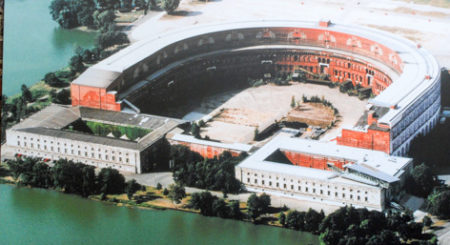
As previously mentioned, the German government believes strongly that its citizens be aware of the dark past with respect to the Nazi party. They are very careful not to memorialize certain sites or buildings associated with the Nazis. However, all the buildings on the Rally Grounds have been designated as historic monuments. Along with the Documentation Center, it fits the overall plan to educate Germans (and others) on the fascist regime and its aftermath and hopefully ensure this will never happen again.
The government has dedicated enough financing to restore the Rally Grounds to ensure it won’t continue to deteriorate and provide for the safety of its visitors.
Bookends of the Nazi Party
After our visit to Zeppelin Field and the Documentation Center, I realized that Nuremberg and these two sites were the bookends to the twelve-year existence of the Nationalist Socialist Party commonly known as the Nazi party.
The events at the Zeppelin Field provided in the beginning, the canvas for the Nazis to paint their propaganda pictures, record their messages, and provide a jumpstart for the surge in German nationalism.
The Nuremberg courtroom provided the epilogue to the Nazi party with the main trial of the leaders and then twelve subsequent trials. We’ll visit Room 600 in our blog two weeks from now.
Recommended Reading
Tusa, Ann and John Tusa. The Nuremberg Trial. New York: Skyhorse Publishing, 2010.
Dodd, Christopher J. with Lary Bloom. Letters from Nuremberg. New York: Three Rivers Press, 2007.
Gregor, Neil. Haunted City: Nuremberg and the Nazi Past. New Haven: Yale University Press, 2008.
Overy, Richard. Interrogations: The Nazi Elite in Allied Hands, 1945. New York: Penguin Books, 2001.
What’s New With Sandy and Stew?
We have finally finished Volume Two of Where Did They Burn the Grand Master of the Knights Templar? A Walking Tour of Medieval Paris. The final manuscript is with Roy Roper, our fantastic book designer. From there it goes to New York where Self-Publishing will convert the file to a “Print on Demand” book. We expect the book to be available by the end of December.
Someone Is Commenting On Our Blogs
If there is a topic you’d like to see a blog written about, please don’t hesitate to contact me. I love hearing from you so keep those comments coming.
Please tell your friends about our blog site and encourage them to visit and subscribe. Sandy and I are trying to increase our audience and we need your help through your friends and social media followers.
Why Would You Want To Buy Our “Walks Through History” Books?
Simple.
You like to travel and experience history and historical events. You like to see original buildings that had a significant impact on the people and events of the history you’re engaged with. You want to know the stories behind the brick and mortar in front of you.
The walking tour books are meticulously researched so you can go directly to those sites and learn about the building’s history as well as an introduction to some of the more interesting people associated with it.
Thank You
Sandy and I appreciate you visiting with us. We have some exciting things on the horizon and we’ll keep you updated as we go along.
Share This:
Follow Stew:
Find Stew’s books on Amazon and iBooks.
Please note that we do not and will not take compensation from individuals or companies mentioned or promoted in the blogs.
Walks Through History
Copyright © 2017 Stew Ross



Stew – Fascinating blog! How sad to see the film of Nuremberg before the destruction of the war. And how sad that Hitler didn’t harness his power and the excitement of the German people for good rather than evil. Wonderful to travel through your eyes! Rhea Seddon